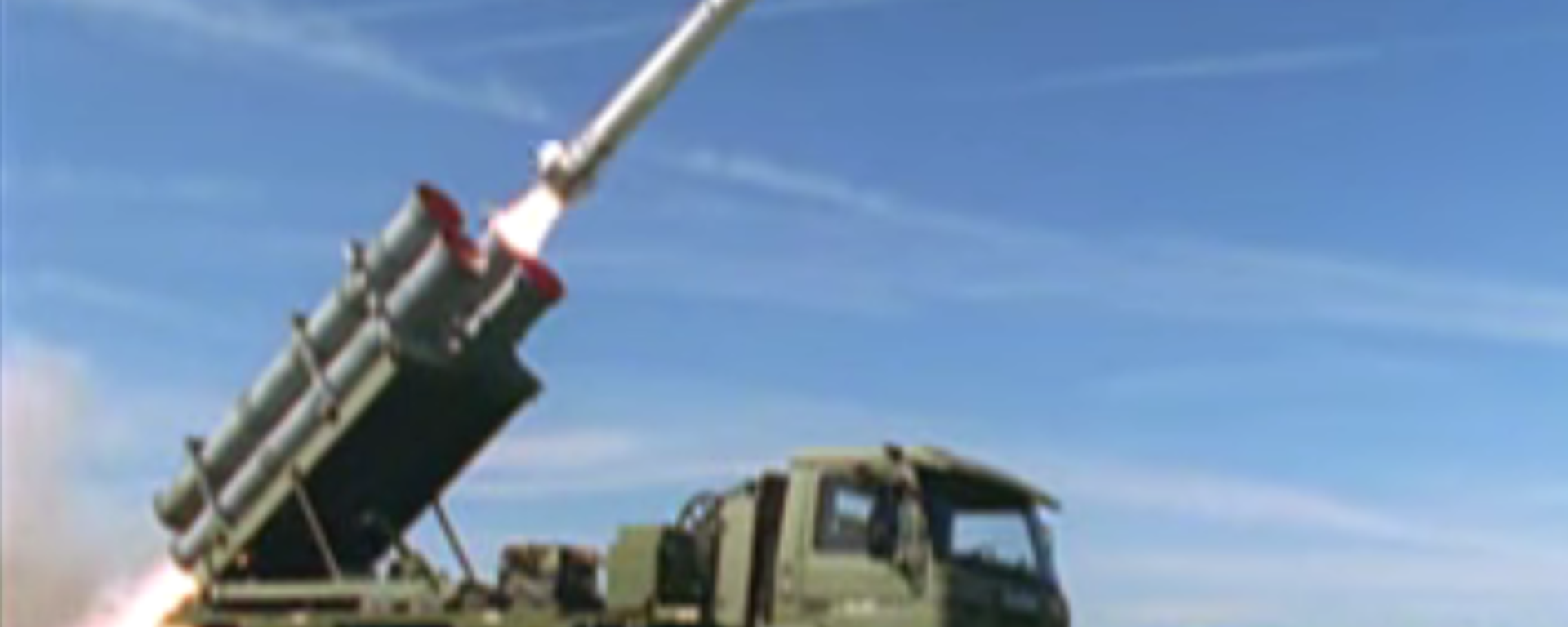https://sputnikglobe.com/20231021/pentagons-crafty-plan-ukraine-to-receive-frankenstein-air-defenses-from-us-1114355508.html
Pentagon's Crafty Plan: Ukraine to Receive 'Frankenstein' Air Defenses From US
Pentagon's Crafty Plan: Ukraine to Receive 'Frankenstein' Air Defenses From US
Sputnik International
The Pentagon has greenlit a new air defense project custom-tailored for Kiev. According to US media reports, Ukraine will receive anti-aircraft missile systems produced in an unusual manner by the US defense industry. Sputnik reports on what Washington has in mind.
2023-10-21T10:08+0000
2023-10-21T10:08+0000
2023-10-21T10:08+0000
russia's special operation in ukraine
us
ukraine
washington
kiev
pentagon
ukrainian armed forces
buk
ronald reagan
igor korotchenko
https://cdn1.img.sputnikglobe.com/img/07e6/0c/0e/1105436450_0:160:3073:1888_1920x0_80_0_0_ac73fea2aefe6176dd10e7562cfa5be2.jpg
The Ukrainian military is experiencing a serious shortage of anti-aircraft defenses. This is because of the Russian forces' use of long-range Lancet kamikaze drones, and the Russian Aerospace Forces deployment of precision-guided glide bombs, which have greatly thinned the ranks of the Ukrainian Armed Forces' frontline air defenses. To protect infantry and equipment, Kiev has been forced to move its air defense systems closer to the front, where they can fall prey to cheap Russian FPV drones.Consequently, Kiev's requests for advanced air defenses from its Western patrons have become increasingly urgent. The armed conflict that has broken out in the Middle East has exacerbated the problem. Israel asked for help from the US on the first day of hostilities. The Pentagon is on the horns of a dilemma - whether Israel or Ukraine is more deserving of its support. The latest rhetoric would suggest that Washington is more inclined to help Tel Aviv, with Ukraine left scrambling for whatever scraps are left.Old 'Monsters' for the FrontlineAccording to one major international news agency, the US Department of Defense believes this approach will quickly provide the Ukrainian Armed Forces with some much-needed air defense capabilities. This, in turn, will prepare the Ukrainian army for the winter campaign.In this way, Washington hopes to achieve three goals at once: it will load its defense industry up with orders for "FrankenSAMs", get rid of obsolete explosives, and demonstrate "support for its ally" to the world.A Reagan-Era Veteran MissileAccording to the media, the Pentagon is working on three projects as part of the FrankenSAM program. The first is almost finished: Ukraine will initially receive a ground-based short-range air defense system with AIM-9M Sidewinder missiles, according to the news agency's source. Without going into detail, the source explained that the chassis, launchers, radar and other equipment for the system will be provided by the US and its allies. This, the media outlet noted, will help "meet Kiev's vital air defense needs" and tackle related issues.Washington announced the delivery of Sidewinder missiles in August, after the release of what was then its latest military aid package. This raised many questions, as the missile is of the air-to-air variety. Ukrainian fighter jets still in service are not capable of firing it without significant modifications to their on-board electronic systems, and the first F-16s for the Ukrainian armed forces are not expected until next spring at the earliest.The AIM-9 Sidewinder is the grandfather of a weapons system that entered production in 1956 and has undergone several upgrades over the years. The forthcoming short-range air defense version of the system will be equipped with the 9M variant, introduced in 1983 and actively used during Operation Desert Storm. The period of most extensive production coincided with the years of this conflict.In the early 2000s, this modification was replaced by the more advanced AIM-9X, with the Reagan-era AIM-9M variants stored away. It's unknown how effective these 30-year-old missiles will be against modern Russian aircraft, but the fact is that the US has enough of these munitions to supply Ukraine for months.Americanized ‘Buk’The second offspring of the FrankenSAM project will be an air defense system based on early versions of the Soviet Buk missile system. The Americans plan to modernize Ukraine's remaining inventory of these systems to accommodate outdated AIM-7 Sparrow air-to-air missiles, which were also introduced in 1956.It's known that the "Buks" will be modified to use the RIM-7 Sea Sparrow ship-based variant of the missile. It seems to be easier to adapt a naval version for land-based launches than an airborne one. Also, similar adaptations have been made before. In the early 1990s, the Pentagon provided Taiwan with 500 RIM-7 missiles modified for ground-based launch. But during exercises in 2012, three of Taiwan's Sea Sparrows malfunctioned and crashed into the sea, prompting Taipei to stop using the missiles.It's unlikely that the American Sparrow arsenal has miraculously become more reliable over the past 11 years. It's also unclear whether these missiles will pose a greater threat to Russian aviation or to the Ukrainians themselves in the area where Ukrainian air defenses are deployed.The same question applies to the third known component of the FrankenSAM project. The Pentagon is working on the modernization of the HAWK medium-range surface-to-air defense system, which was introduced in 1959. Ukraine already operates several of these systems, but no reports on their success have been published by Ukrainian command.However, improvised air defenses can be effective. The Yugoslav experience in 1999 demonstrated this when an outdated Serbian S-125 system successfully shot down a state-of-the-art American stealth fighter, the F-117.Furthermore, the FrankenSAM project is unlikely to be an attempt to move away from the Ukrainian issue and gradually cut off military supplies.The FrankenSAM project is likely to be a temporary fix. The US is at present actively reviving its defense production to replenish depleted stockpiles - its own, Ukraine's, and those of NATO allies. The purpose of these makeshift anti-aircraft missile "monsters" is to buy the Ukrainian military time until factories are operating at full capacity.
https://sputnikglobe.com/20231020/white-house-asks-congress-for-106bln-to-support-ukraine-israel-us-border-other-matters-1114364008.html
https://sputnikglobe.com/20231011/us-to-lead-coalition-of-countries-workin-with-ukraine-to-develop-its-air-force---pentagon-chief-1114105848.html
https://sputnikglobe.com/20230417/report-us-to-sell-taiwan-400-anti-ship-harpoon-missiles-to-repel-chinese-invasion-1109607447.html
https://sputnikglobe.com/20231007/russian-air-defense-systems-destroy-ukrainian-s-200-missile-flying-to-crimea-1114008576.html
ukraine
washington
kiev
Sputnik International
feedback@sputniknews.com
+74956456601
MIA „Rossiya Segodnya“
2023
Andrey Kots
https://cdn1.img.sputnikglobe.com/img/07e7/09/0d/1113345217_428:0:2132:1704_100x100_80_0_0_572c3cfc2b7e5fdab0f340359bd4760b.jpg
Andrey Kots
https://cdn1.img.sputnikglobe.com/img/07e7/09/0d/1113345217_428:0:2132:1704_100x100_80_0_0_572c3cfc2b7e5fdab0f340359bd4760b.jpg
News
en_EN
Sputnik International
feedback@sputniknews.com
+74956456601
MIA „Rossiya Segodnya“
Sputnik International
feedback@sputniknews.com
+74956456601
MIA „Rossiya Segodnya“
Andrey Kots
https://cdn1.img.sputnikglobe.com/img/07e7/09/0d/1113345217_428:0:2132:1704_100x100_80_0_0_572c3cfc2b7e5fdab0f340359bd4760b.jpg
frankensam, ukraine, sam, russia, nato, proxy war, frankenstein, united states, air defense
frankensam, ukraine, sam, russia, nato, proxy war, frankenstein, united states, air defense
Pentagon's Crafty Plan: Ukraine to Receive 'Frankenstein' Air Defenses From US
The Pentagon has greenlit a new air defense project custom-made for Kiev. According to US media reports, Ukraine will receive anti-aircraft missile systems produced in an unusual manner by the US defense industry. Sputnik examines what Washington has in mind.
The Ukrainian military is experiencing a serious shortage of anti-aircraft defenses. This is because of the Russian forces' use of long-range Lancet kamikaze drones, and the Russian Aerospace Forces deployment of precision-guided glide bombs, which have greatly thinned the ranks of the Ukrainian Armed Forces' frontline air defenses. To protect infantry and equipment, Kiev has been forced to move its air defense systems closer to the front, where they can fall prey to cheap Russian FPV drones.
Consequently, Kiev's requests for advanced air defenses from its Western patrons have become increasingly urgent. The armed conflict that has broken out in the Middle East has exacerbated the problem. Israel asked for help from the US on the first day of hostilities. The Pentagon is on the horns of a dilemma - whether Israel or Ukraine is more deserving of its support. The latest rhetoric would suggest that Washington is more inclined to help Tel Aviv, with Ukraine left scrambling for whatever scraps are left.
Old 'Monsters' for the Frontline
Step forward the FrankenSAM (a portmanteau word of "Frankenstein" and "SAM" [surface-to-air missile]) program. The plan involves the development and production of improvised air defense systems using components and materials from Ukrainian, US and allied stockpiles. Old decommissioned anti-aircraft missiles will be repurposed as ammunition for these "chimeras".
According to one major international news agency, the US Department of Defense believes this approach will quickly provide the Ukrainian Armed Forces with some much-needed air defense capabilities. This, in turn, will prepare the Ukrainian army for the winter campaign.
In this way, Washington hopes to achieve three goals at once: it will load its defense industry up with orders for "FrankenSAMs", get rid of obsolete explosives, and demonstrate "support for its ally" to the world.

20 October 2023, 16:31 GMT
A Reagan-Era Veteran Missile
According to the media, the Pentagon is working on three projects as part of the FrankenSAM program. The first is almost finished: Ukraine will initially receive a ground-based short-range air defense system with AIM-9M Sidewinder missiles, according to the news agency's source. Without going into detail, the source explained that the chassis, launchers, radar and other equipment for the system will be provided by the US and its allies. This, the media outlet noted, will help "meet Kiev's vital air defense needs" and tackle related issues.
Washington announced the delivery of Sidewinder missiles in August, after the release of what was then its latest military aid package. This raised many questions, as the missile is of the air-to-air variety. Ukrainian fighter jets still in service are not capable of firing it without significant modifications to their on-board electronic systems, and the first F-16s for the Ukrainian armed forces are not expected until next spring at the earliest.
In addition, the Sidewinder is only effective at short range, whereas Russian pilots prefer long-range engagements. The news about the modification of these missiles for ground use clarifies the situation.

11 October 2023, 15:20 GMT
The AIM-9 Sidewinder is the grandfather of a weapons system that entered production in 1956 and has undergone several upgrades over the years. The forthcoming short-range air defense version of the system will be equipped with the 9M variant, introduced in 1983 and actively used during Operation Desert Storm. The period of most extensive production coincided with the years of this conflict.
In the early 2000s, this modification was replaced by the more advanced AIM-9X, with the Reagan-era AIM-9M variants stored away. It's unknown how effective these 30-year-old missiles will be against modern Russian aircraft, but the fact is that the US has enough of these munitions to supply Ukraine for months.
The second offspring of the FrankenSAM project will be an air defense system based on early versions of the Soviet Buk missile system. The Americans plan to modernize Ukraine's remaining inventory of these systems to accommodate outdated AIM-7 Sparrow air-to-air missiles, which were also introduced in 1956.
Unlike the AIM-9, the AIM-7 Sparrow is a medium-range air defense missile capable of engaging targets up to 20 to 25 kilometers away. The original Buk missiles have a much longer range, but it appears that Ukraine has almost none left.
It's known that the "Buks" will be modified to use the RIM-7 Sea Sparrow ship-based variant of the missile. It seems to be easier to adapt a naval version for land-based launches than an airborne one. Also, similar adaptations have been made before. In the early 1990s, the Pentagon provided Taiwan with 500 RIM-7 missiles modified for ground-based launch. But during exercises in 2012, three of Taiwan's Sea Sparrows malfunctioned and crashed into the sea, prompting Taipei to stop using the missiles.
It's unlikely that the American Sparrow arsenal has miraculously become more reliable over the past 11 years. It's also unclear whether these missiles will pose a greater threat to Russian aviation or to the Ukrainians themselves in the area where Ukrainian air defenses are deployed.
The same question applies to the third known component of the FrankenSAM project. The Pentagon is working on the modernization of the HAWK medium-range surface-to-air defense system, which was introduced in 1959. Ukraine already operates several of these systems, but no reports on their success have been published by Ukrainian command.
However, improvised air defenses can be effective. The Yugoslav experience in 1999 demonstrated this when an outdated Serbian S-125 system successfully shot down a state-of-the-art American stealth fighter, the F-117.
Furthermore, the FrankenSAM project is unlikely to be an attempt to move away from the Ukrainian issue and gradually cut off military supplies.
Rather, "the US and the European Union have a consolidated position whereby - at least for the next three years - the volume of arms and military equipment supplies to Ukraine will be maintained and will tend to increase," said Igor Korotchenko, a military analyst and editor-in-chief of National Defense magazine. "We must not delude ourselves with false hopes and illusions that the support will stop, especially in light of recent reports of contradictions in the West."
The FrankenSAM project is likely to be a temporary fix. The US is at present actively reviving its defense production to replenish depleted stockpiles - its own, Ukraine's, and those of NATO allies. The purpose of these makeshift anti-aircraft missile "monsters" is to buy the Ukrainian military time until factories are operating at full capacity.

7 October 2023, 20:07 GMT







